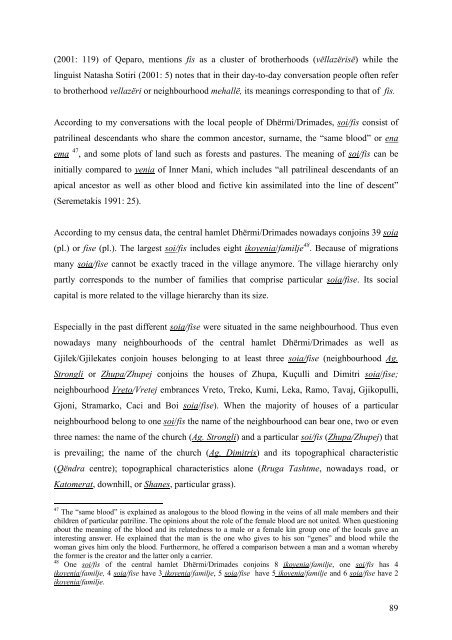university of nova gorica graduate school contested spaces and ...
university of nova gorica graduate school contested spaces and ...
university of nova gorica graduate school contested spaces and ...
Create successful ePaper yourself
Turn your PDF publications into a flip-book with our unique Google optimized e-Paper software.
(2001: 119) <strong>of</strong> Qeparo, mentions fis as a cluster <strong>of</strong> brotherhoods (vëllazërisë) while the<br />
linguist Natasha Sotiri (2001: 5) notes that in their day-to-day conversation people <strong>of</strong>ten refer<br />
to brotherhood vellazëri or neighbourhood mehallë, its meanings corresponding to that <strong>of</strong> fis.<br />
According to my conversations with the local people <strong>of</strong> Dhërmi/Drimades, soi/fis consist <strong>of</strong><br />
patrilineal descendants who share the common ancestor, surname, the “same blood” or ena<br />
ema 47 , <strong>and</strong> some plots <strong>of</strong> l<strong>and</strong> such as forests <strong>and</strong> pastures. The meaning <strong>of</strong> soi/fis can be<br />
initially compared to yenia <strong>of</strong> Inner Mani, which includes “all patrilineal descendants <strong>of</strong> an<br />
apical ancestor as well as other blood <strong>and</strong> fictive kin assimilated into the line <strong>of</strong> descent”<br />
(Seremetakis 1991: 25).<br />
According to my census data, the central hamlet Dhërmi/Drimades nowadays conjoins 39 soia<br />
(pl.) or fise (pl.). The largest soi/fis includes eight ikoyenia/familje 48 . Because <strong>of</strong> migrations<br />
many soia/fise cannot be exactly traced in the village anymore. The village hierarchy only<br />
partly corresponds to the number <strong>of</strong> families that comprise particular soia/fise. Its social<br />
capital is more related to the village hierarchy than its size.<br />
Especially in the past different soia/fise were situated in the same neighbourhood. Thus even<br />
nowadays many neighbourhoods <strong>of</strong> the central hamlet Dhërmi/Drimades as well as<br />
Gjilek/Gjilekates conjoin houses belonging to at least three soia/fise (neighbourhood Ag.<br />
Strongli or Zhupa/Zhupej conjoins the houses <strong>of</strong> Zhupa, Kuçulli <strong>and</strong> Dimitri soia/fise;<br />
neighbourhood Vreto/Vretej embrances Vreto, Treko, Kumi, Leka, Ramo, Tavaj, Gjikopulli,<br />
Gjoni, Stramarko, Caci <strong>and</strong> Boi soia/fise). When the majority <strong>of</strong> houses <strong>of</strong> a particular<br />
neighbourhood belong to one soi/fis the name <strong>of</strong> the neighbourhood can bear one, two or even<br />
three names: the name <strong>of</strong> the church (Ag. Strongli) <strong>and</strong> a particular soi/fis (Zhupa/Zhupej) that<br />
is prevailing; the name <strong>of</strong> the church (Ag. Dimitris) <strong>and</strong> its topographical characteristic<br />
(Qëndra centre); topographical characteristics alone (Rruga Tashtme, nowadays road, or<br />
Katomerat, downhill, or Shanes, particular grass).<br />
47 The “same blood” is explained as analogous to the blood flowing in the veins <strong>of</strong> all male members <strong>and</strong> their<br />
children <strong>of</strong> particular patriline. The opinions about the role <strong>of</strong> the female blood are not united. When questioning<br />
about the meaning <strong>of</strong> the blood <strong>and</strong> its relatedness to a male or a female kin group one <strong>of</strong> the locals gave an<br />
interesting answer. He explained that the man is the one who gives to his son “genes” <strong>and</strong> blood while the<br />
woman gives him only the blood. Furthermore, he <strong>of</strong>fered a comparison between a man <strong>and</strong> a woman whereby<br />
the former is the creator <strong>and</strong> the latter only a carrier.<br />
48<br />
One soi/fis <strong>of</strong> the central hamlet Dhërmi/Drimades conjoins 8 ikoyenia/familje, one soi/fis has 4<br />
ikoyenia/familje, 4 soia/fise have 3 ikoyenia/familje, 5 soia/fise have 5 ikoyenia/familje <strong>and</strong> 6 soia/fise have 2<br />
ikoyenia/familje.<br />
89

















